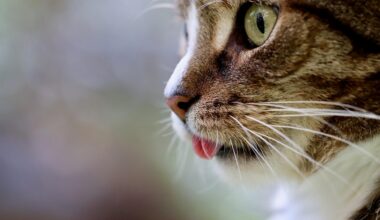Monitoring and Tracking Vaccinated Stray Cats
Vaccination of stray cats plays a pivotal role in improving public health and animal welfare. Implementing systematic monitoring and tracking can significantly maximize the positive impacts of these vaccinations. Effective tracking ensures that stray cats receive necessary vaccines promptly, reducing the spread of diseases like rabies. In addition, having accurate records assists veterinarians and animal control agencies in assessing the overall health of local stray populations. Utilizing technology, such as mobile apps or database systems, can streamline the collection and analysis of vaccination data. Integrating GPS tracking, for example, allows us to monitor movements and rescues of vaccinated animals, creating a comprehensive status overview. In the end, providing vaccinations for stray cats not only protects the specific animals but also minimizes health risks for humans. Collaboration within communities to track these vaccinations is essential. Stray cat colonies can then be managed safely and humanely, ensuring their health and preventing disease transmission. Awareness programs can educate the public about the importance of these vaccinations, fostering positive community interactions with local strays.
While many communities engage in TNR (Trap-Neuter-Return) programs, it is crucial to incorporate vaccination efforts into these initiatives. Vaccination during the TNR process is vital, as it ensures the most vulnerable strays receive protection against specific diseases. Keeping detailed records of each vaccinated stray is critical for tracking their health status over time. Additionally, registering these animals with local authorities helps manage strays more effectively. Establishing partnerships with local veterinarians can provide access to affordable vaccine options and promote regular health check-ups. They can also assist in delivering educational outreach about the ongoing needs of these cats post-vaccination. Efforts should include consistent follow-ups for booster shots within the required timeframes. Moreover, creating public awareness campaigns makes communities rethink their perceptions of stray cats, promoting more compassion and understanding towards their needs. A robust vaccination tracking program can lead to healthier street populations. In the end, dedicated community involvement is crucial to ensure vaccines reach every eligible stray and maintain sustained health improvements in these populations.
The Importance of Community Engagement
Community involvement is essential when discussing vaccination programs for stray cats. Volunteers and local authorities working together can create a strong support system for these animals. Establishing designated days for vaccination clinics and promoting them via local media can draw attention to the issue. Additionally, pet owners can be engaged to help spot and report stray cats in need of vaccination. Educating community members helps them understand the benefits of vaccination, not only for the cats but also for public health. Communities that prioritize cat welfare often see reduced stray populations over time. Motivation to participate in efforts like TNR or vaccination drives can be initiated through personal stories shared by volunteers. Social media platforms can serve as excellent tools for outreach. Publicizing the successes of vaccinated stray cats can evoke empathy and encourage further participation and donations. Furthermore, recognizing volunteer efforts with public commendations fosters a continued commitment to help these vulnerable animals. Establishing clear goals for community engagement ensures that stray cats receive vaccinations that help them thrive in their environment.
Monitoring data on vaccinated stray populations can provide valuable insights for future initiatives. Analyzing trends over time can showcase the efficacy of vaccination programs and identify areas needing improvement. By tracking vaccination statistics, we can better allocate resources to regions with higher stray cat populations. It also enables us to ascertain if certain vaccination methods yield better results. Documented observations can highlight the need for specific vaccinations against prevalent diseases in the area. Understanding the demographics of vaccinated cats helps tailor outreach methods to ensure compliance. Furthermore, collaboration with animal welfare organizations can amplify the impact of vaccination tracking. Shared data sets allow for comprehensive understanding among diverse stakeholders of the issues at hand. Implementing studies focused on the long-term health of vaccinated cats could revolutionize standard practices within animal welfare. The broader implications motivate research and catch the attention of the scientific community on the potential benefits of mass vaccination of strays. Ultimately, integrating this data into public discussions can lead to enhanced policies and elevated awareness, creating safer environments for both strays and humans.
The Role of Technology in Tracking
Utilizing technology has revolutionized how we can monitor and track vaccinated stray cats. The development of mobile applications allows volunteers to record vaccination data effectively. These dashboards can provide vital statistics and a comprehensive overview of local stray cat populations. Additionally, GPS collars can offer real-time tracking capabilities for specific stray cats. By understanding their movements, caretakers can assess if areas need additional resources for vaccinations. Using social media can also help share vaccination milestones and continuing needs of the stray population. Online platforms can facilitate discussions about successes, fostering a community around addressing these issues collectively. Community members engaged through technology can easily collaborate on events focused on caring for local strays. Regular updates shared through technology help maintain transparency and continuous engagement among all stakeholders. As a result, they develop relationships based on compassion and understanding. The benefits of enhanced data sharing cannot be overstated, as it allows effective planning and evaluation. Embracing these technological advancements can revolutionize how stray vaccination programs operate. Overall, leveraging technology has the potential to create lasting change within communities.
As we recognize the incredible importance of tracking vaccinated stray cats, one must consider the implications of oversight. Regular audits of vaccination data ensure that all information is accurate and up-to-date. This oversight not only reinforces trust but also allows for strategic improvements to vaccination initiatives. Maintaining accurate records assists veterinarians in monitoring the health of both individual cats and entire colonies. Furthermore, it provides essential data for grant applications and fundraising initiatives aimed at funding vaccination initiatives. Collaborative projects with research universities may yield studies around vaccination impacts. Proper oversight ensures accountability among volunteers involved in cat welfare. Clear policies on record-keeping and data sharing promote streamlined communication among stakeholders. Creating a dedicated advisory board can enhance oversight and ensure data integrity. Membership on this board should include representatives from veterinary clinics, community organizations, and animal control agencies. Regular meetings can push forward common goals related to stray cat welfare. In conclusion, effective monitoring allows for continuous improvement and elevates the conversation around the welfare of vulnerable animals found within our communities.
Conclusion and Future Directions
As we move forward in supporting stray cat vaccination efforts, it’s vital to consider future directions. Widespread awareness campaigns on the importance of vaccinations can engender widespread community support. By fostering collaboration among local authorities, volunteers, and organizations, we can boost our collective impact. We should continue promoting TNR programs alongside vaccination efforts, ensuring sustainable welfare practices. Engaging with local businesses can lead to funding partnerships for vaccination programs. Additionally, employing mobile technology will allow us to track and report on the success of these endeavors. Future developments in vaccination methods may also play a role in enhancing efficiency and effectiveness. As animal welfare continues to evolve, methodologies need to adapt and refine to ensure maximum impact. Reporting results from tracking initiatives can provide a broader understanding of these programs’ successes and challenges. By collecting feedback from community members and stakeholders, ongoing improvements can be implemented. This collaborative approach paves the way for resilient solutions in tackling stray cat populations. In summary, constant adaptation and overlapped strategies strengthen the framework for achieving optimal outcomes in stray cat health initiatives.
Promoting the health of stray cats through vaccination programs is an ongoing journey that requires the support of the entire community. As stakeholders, we must remain committed to continuous improvements while ensuring that our efforts are data-driven and responsive to the needs around us. Working collectively, we can create sustainable and effective vaccination strategies.


